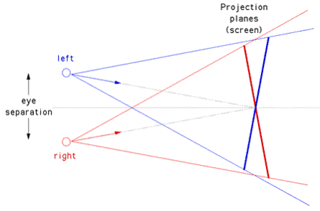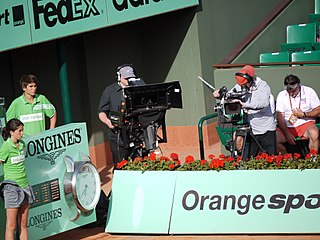
Stereoscopy is a technique for creating or enhancing the illusion of depth in an image by means of stereopsis for binocular vision. The word stereoscopy derives from Greek στερεός (stereos) 'firm, solid', and σκοπέω (skopeō) 'to look, to see'. Any stereoscopic image is called a stereogram. Originally, stereogram referred to a pair of stereo images which could be viewed using a stereoscope.

Depth perception is the ability to perceive distance to objects in the world using the visual system and visual perception. It is a major factor in perceiving the world in three dimensions. Depth perception happens primarily due to stereopsis and accommodation of the eye.

An autostereogram is a two-dimensional (2D) image that can create the optical illusion of a three-dimensional (3D) scene. Autostereograms use only one image to accomplish the effect while normal stereograms require two. The 3D scene in an autostereogram is often unrecognizable until it is viewed properly, unlike typical stereograms. Viewing any kind of stereogram properly may cause the viewer to experience vergence-accommodation conflict.

The Pulfrich effect is a psychophysical percept wherein lateral motion of an object in the field of view is interpreted by the visual cortex as having a depth component, due to a relative difference in signal timings between the two eyes.

A 3D display is a display device capable of conveying depth to the viewer. Many 3D displays are stereoscopic displays, which produce a basic 3D effect by means of stereopsis, but can cause eye strain and visual fatigue. Newer 3D displays such as holographic and light field displays produce a more realistic 3D effect by combining stereopsis and accurate focal length for the displayed content. Newer 3D displays in this manner cause less visual fatigue than classical stereoscopic displays.
Random-dot stereogram (RDS) is stereo pair of images of random dots which, when viewed with the aid of a stereoscope, or with the eyes focused on a point in front of or behind the images, produces a sensation of depth, with objects appearing to be in front of or behind the display level.

Anaglyph 3D is the stereoscopic 3D effect achieved by means of encoding each eye's image using filters of different colors, typically red and cyan. Anaglyph 3D images contain two differently filtered colored images, one for each eye. When viewed through the "color-coded" "anaglyph glasses", each of the two images reaches the eye it's intended for, revealing an integrated stereoscopic image. The visual cortex of the brain fuses this into the perception of a three-dimensional scene or composition.
Stereopsis is the component of depth perception retrieved through binocular vision. Stereopsis is not the only contributor to depth perception, but it is a major one. Binocular vision happens because each eye receives a different image because they are in slightly different positions in one's head. These positional differences are referred to as "horizontal disparities" or, more generally, "binocular disparities". Disparities are processed in the visual cortex of the brain to yield depth perception. While binocular disparities are naturally present when viewing a real three-dimensional scene with two eyes, they can also be simulated by artificially presenting two different images separately to each eye using a method called stereoscopy. The perception of depth in such cases is also referred to as "stereoscopic depth".

Autostereoscopy is any method of displaying stereoscopic images without the use of special headgear, glasses, something that affects vision, or anything for eyes on the part of the viewer. Because headgear is not required, it is also called "glasses-free 3D" or "glassesless 3D". There are two broad approaches currently used to accommodate motion parallax and wider viewing angles: eye-tracking, and multiple views so that the display does not need to sense where the viewer's eyes are located. Examples of autostereoscopic displays technology include lenticular lens, parallax barrier, and may include Integral imaging, but notably do not include volumetric display or holographic displays.
Phantograms, also known as Phantaglyphs, Op-Ups, free-standing anaglyphs, levitated images, and book anaglyphs, are a form of optical illusion. Phantograms use perspectival anamorphosis to produce a 2D image that is distorted in a particular way so as to appear, to a viewer at a particular vantage point, three-dimensional, standing above or recessed into a flat surface. The illusion of depth and perspective is heightened by stereoscopy techniques; a combination of two images, most typically but not necessarily an anaglyph. With common (red–cyan) 3D glasses, the viewer's vision is segregated so that each eye sees a different image.
Binocular disparity refers to the difference in image location of an object seen by the left and right eyes, resulting from the eyes’ horizontal separation (parallax). The brain uses binocular disparity to extract depth information from the two-dimensional retinal images in stereopsis. In computer vision, binocular disparity refers to the difference in coordinates of similar features within two stereo images.

A 3D stereo view is the viewing of objects through any stereo pattern.
Stereoscopic depth rendition specifies how the depth of a three-dimensional object is encoded in a stereoscopic reconstruction. It needs attention to ensure a realistic depiction of the three-dimensionality of viewed scenes and is a specific instance of the more general task of 3D rendering of objects in two-dimensional displays.
A stereographer is a professional in the field of stereoscopy and visual effects using the art and techniques of stereo photography, 3D photography, or stereoscopic 3D film to create a visual perception of a 3-dimensional image from a flat surface. A stereographer may take a single 2D image and create a stereogram from it.
2D to 3D video conversion is the process of transforming 2D ("flat") film to 3D form, which in almost all cases is stereo, so it is the process of creating imagery for each eye from one 2D image.
Stereoscopic acuity, also stereoacuity, is the smallest detectable depth difference that can be seen in binocular vision.

Stereo photography techniques are methods to produce stereoscopic images, videos and films. This is done with a variety of equipment including special built stereo cameras, single cameras with or without special attachments, and paired cameras. This involves traditional film cameras as well as, tape and modern digital cameras. A number of specialized techniques are employed to produce different kinds of stereo images.
Stereoscopic motion, as introduced by Béla Julesz in his book Foundations of Cyclopean Perception of 1971, is a translational motion of figure boundaries defined by changes in binocular disparity over time in a real-life 3D scene, a 3D film or other stereoscopic scene. This translational motion gives rise to a mental representation of three dimensional motion created in the brain on the basis of the binocular motion stimuli. Whereas the motion stimuli as presented to the eyes have a different direction for each eye, the stereoscopic motion is perceived as yet another direction on the basis of the views of both eyes taken together. Stereoscopic motion, as it is perceived by the brain, is also referred to as cyclopean motion, and the processing of visual input that takes place in the visual system relating to stereoscopic motion is called stereoscopic motion processing.
The Van Hare Effect is a 3D stereoscopic viewing technique for creating or enhancing the illusion of depth in an image by means of stereopsis for binocular vision using psychophysical percepts. The Van Hare Effect creates the illusion of dimensionality, rather than actual dimensionality in the subject being viewed. The Van Hare Effect is achieved by employing the stereoscopic cross-eyed viewing technique on a pair of identical images placed side-by-side. In doing so, it artificially tricks the human brain and optical center into seeing depth in what is actually a two-dimensional, non-stereoscopic image. The illusion of depth is interesting in that even if the image pair is not itself originally stereoscopic, the brain perceives it as if it is.

Vergence-accommodation conflict (VAC), also known as accommodation-vergence conflict, is a visual phenomenon that occurs when the brain receives mismatching cues between vergence and accommodation of the eye. This commonly occurs in virtual reality devices, augmented reality devices, 3D movies, and other types of stereoscopic displays and autostereoscopic displays. The effect can be unpleasant and cause eye strain.

















